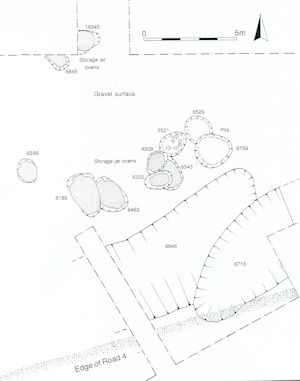
Along with the pits and other miscellaneous features of late 1st and early 2nd century features, OA19 is particularly notable for the occurrence of storage jar ovens (Figure 88).
It is significant that these storage jar ovens seem to be located mainly around the edges of the sub-enclosure, and suggest a role in food production (even retail?) complementing the perceived public function of the area. Furthermore, it may be conjectured that, along with the OA18 ovens, this is associated with activities of the adjacent temple complex (for discussion see Vol. 1).
Along with those in OA18, storage jar ovens are particularly numerous at the west end of OA19. All more-or-less lie within its second sub-enclosure (although 6441 and 6551 have an uncertain relationship with northern sub-enclosure ditch 25258 and technically lie outside its interior).

A total of fifteen such hearths are recorded in the western part of OA19. The majority form a close cluster (Groups 477, 503, 512), midway along the south side of sub-enclosure 2, next to Road 4 (Figure 116). All are set into the gravel surfacing, their storage jars laid on side within shallow construction cuts, which presumably keeps the ovens in a stable position during use. While most are single-phase structures, ovens 6189, 6323 and 6462 each contain three phases of storage jar within a single cut - each jar set directly on the remains of another. As well as this simple on-going replacement, defunct oven are also abandoned and entirely new ones established in slightly differing positions - as indicated by inter-cut ovens 6308/6323/6343 and 6189/6462. Either way, the persistent siting of these features shows that the location of the cooking activity that they represent is relatively static and long-lived at this location.
Two outliers, ovens 6845 and 16345 (Groups 477, 503) were recorded in the field as being sealed below the Period 3 gravel surfaces. However this stratigraphic relationship is over-ruled as the ovens best fit here and it is likely that the gravel deposits overlying their remains represent repairs and reinstatement following their disuse.
Further ovens lie toward the north side of the sub-enclosure (6939, 6958 Group 519) and, as previously noted, some at its eastern entrance (6441 Group 591, 6456 Group 501, 6551 Group 499). Oven 6456 is overlain by a patch of gravel 6452 (Group 502) presumably a Period 3 repair to the existing Period 2B surface into which the oven was bedded - perhaps carried out once the oven became defunct in order to reinstate this part of the sub-enclosure occupation surface. Oven 6551 is similarly sealed by the Group 500 gravels and one of the southern ovens (6845 Group 477) by gravel surface fragment Group 484. Although this surface has previously been regarded as a possible Period 2B layer, it is perhaps more likely that it represents a similar reinstatement.
Although only that part of the storage jar embedded in the ground generally survives, it seems evident that further pottery in the oven fills represents collapsed upper parts of what were once whole vessels. All these ovens bear signs of heating and fire blackening across their bases, though not of a particularly intense nature sufficient to cause distinctive scorching, fissuring or vitrification. Oven infills are not particularly rich in large charcoal fragments or ash indicative of in situ burning of fuel. While some charcoal content is present, the often high incidence of burnt stones (e.g. 6399, 6529, 16345) would suggest that the heat source was less direct and that a hot stone method of cooking was employed. Albeit elsewhere, the stones in oven 9506 (Group 767, OA47, Northern Zone) are a particularly good example of this, being of uniform size and shape and presumably deliberately selected for the purpose. It is likely that embers and heated stones are introduced into the ovens, perhaps being prepared in adjacent fire pits such as 6529 and 6759 (see below).
Adjacent to the main, southern, cluster of ovens, inter-cutting small, shallow pits 6759 (Group 486) and 6529 (Group 507) contain quantities of charcoal, together with burnt flint and quartzite pebbles, and may be associated with the use of the ovens. Whether pits such as this were simply for the disposal of oven waste, or were used to heat stones and embers in the ovens themselves, is uncertain.
Internet Archaeology is an open access journal based in the Department of Archaeology, University of York. Except where otherwise noted, content from this work may be used under the terms of the Creative Commons Attribution 3.0 (CC BY) Unported licence, which permits unrestricted use, distribution, and reproduction in any medium, provided that attribution to the author(s), the title of the work, the Internet Archaeology journal and the relevant URL/DOI are given.
Terms and Conditions | Legal Statements | Privacy Policy | Cookies Policy | Citing Internet Archaeology
Internet Archaeology content is preserved for the long term with the Archaeology Data Service. Help sustain and support open access publication by donating to our Open Access Archaeology Fund.